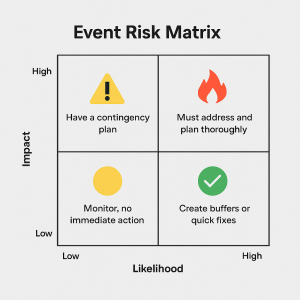Live events constantly shift. Vendors cancel, tech fails, and weather disrupts setup. That’s why every planner should build an event risk management plan.
What Is Risk Management in Event Planning? Risk management is the process of identifying potential issues before they happen—and putting plans in place to either prevent or respond to them. In the event world, that means everything from vendor failure to power outages to crowd control problems. A good risk plan won’t stop problems from happening, but it will stop them from escalating.
Whether you’re producing a red carpet premiere or a corporate retreat, a clear event risk management plan helps you protect your team, support your client, and stay calm under pressure.
Here are five steps to build an event risk management plan that fits into any event workflow.
Step 1: Identify Risks Early (Before They Sneak Up on You)
First, start risk planning during your kickoff phase. Set aside time to brainstorm potential risks across every category:
- Vendors
- Technical systems
- Weather and venue issues
- Permits, insurance, and logistics
- Attendee safety and guest experience
Example:
If your event includes international performers, travel delays should be flagged early as a risk. Early identification sets the foundation. If it’s happened before—or could happen now—get it on the radar.
More Resource: Skift Meetings on Five Situations Where You’ll Need a Backup Plan
Step 2: Categorize by Impact and Likelihood

Next, use a simple matrix to rate each risk by two criteria:
- Likelihood – How likely is it to occur?
- Impact – How disruptive would it be?
Example:
Red carpet arrival gets delayed due to talent transportation issues:
High impact, medium likelihood → needs a plan for pacing, press holding, and comms.
Not all risks are equal. Focus your planning effort where the damage would be greatest and the chance is highest.
Step 3: Create Mitigation and Contingency Plans
Then, develop a plan for each top risk. Address it in two parts:
- Mitigation – What can we do to reduce the chance it happens?
- Contingency – What will we do if it does?
Example:
Risk – Key speaker may cancel last minute
Mitigation – Have signed contracts with penalties and regular check-ins
Contingency – Pre-approved backup speaker and updated run-of-show with adjusted timing
You don’t need a plan for every single risk, just the big ones. With clear strategies in place, your team can move confidently when problems arise.
Step 4: Assign Risk Owners
Additionally, assign responsibility. Every major risk needs a designated team member who will:
- Monitoring the risk
- Executing the contingency if needed
- Alert stakeholders if escalation is required
Example:
If the venue’s loading dock becomes unavailable, the logistics lead alerts the production manager, who contacts the event producer if alternative timing or vendor rerouting is required.
Clear ownership + clear chain of command = faster, calmer response under pressure.
Step 5: Share Key Risks with Client or Stakeholders to Build Trust
Finally, don’t keep your plan internal. Share the top 3–5 risks with your client or key stakeholders along with your proposed solutions. This builds trust and sets expectations in advance.
Example:
“We’ve secured a backup generator for $X within budget and have a contingency timeline if the venue experiences a power issue.”
Transparency is part of good risk management. When clients understand the plan, they’re more likely to stay calm and confident if adjustments are needed.
Final Thoughts
Building an event risk management plan is one of the smartest ways to set your team and client up for success. It doesn’t have to be complicated. Even a basic, well-structured plan can prevent delays, reduce stress, and protect the guest experience.
If you haven’t added risk planning into your workflow yet, now is the time. It shows leadership, builds client confidence, and helps your team operate more efficiently.
Need help developing an event risk management plan for your show or business? We offer event operations consulting, show planning support, and team training tailored to your scale and style.
Let’s Talk!
